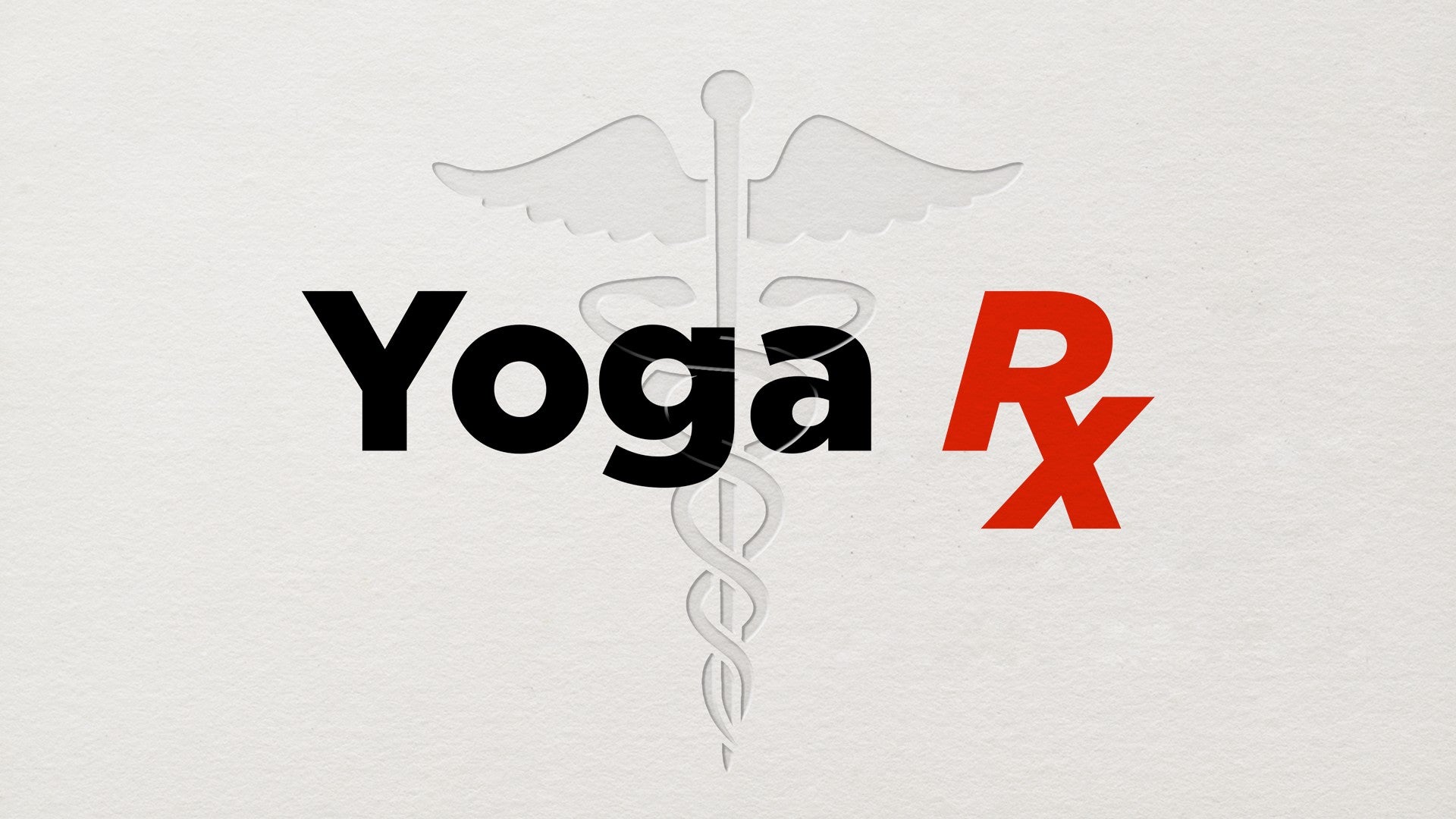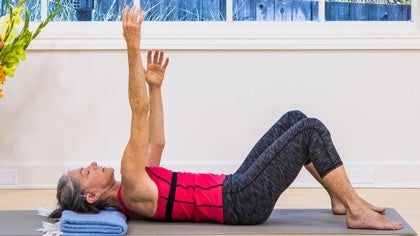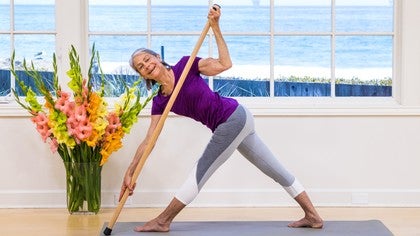Description
Transcript
Read Full Transcript
(waves washing) In this practice, I'm gonna show you and I hope you'll join me, working with a dowel. The dowel helps me to keep my lower spine from collapsing, in doing the standing poses, and it also helps to take weight out of the hips and the knees, so, it's just, almost like doing it out in space, not quite weightless but much less weight into the joints. So I'm starting with, we'll start with a wide standing, and, we're gonna just bring the dowel right in front of the face, straight down, and then find a place, just about shoulder height or head height, face height, to grasp your hands around the pole and push down, and, you want to to be gripping your shoulders downward as you do this. I'm gonna turn around for a moment so you can see that, so, when you're standing, you don't want to be drawing, and there might be some tendency to try to draw the shoulders up by the ears, descend your shoulders and really draw the shoulder blades onto the back body, as you're pushing the pole down. So you'll be stabilizing your shoulders as you do this and you should be feeling by now, that you're carrying less weight on your legs, all three sets of load joints, the hips, the knees and the ankles, carry the load.
OK, I can also feel that I can open up across the groin while I'm doing this. Now, I'm gonna bend my knees and we're gonna come into warrior pose, turning the right foot out, left foot heel goes out, and I'm gonna move the dowel over a little bit, to carry my weight as I come over. Experiment with where the hands can be used to the greatest benefit with the least amount of work, so they have to work, I'm gonna come up now, inhale, spin the feet around, change the hands on the dowel, exhale, come down to the left. So we're not holding for a long period of time, we're lubricating the hip joint, by coming in and out of this pose, and we're taking weight off of the lower spine and sacrum area, by pushing down on this pole. (inhales) Inhale up, (exhales) shift the dowel, turn, inhale, exhale down.
So sometimes I keep the dowel straight, more or less straight up, while I'm doing this, and sometimes I have the dowel more out in front of the first foot, so that there's an angular pressure that I can put, which is also quite useful. So I'm gonna do one more time to the right, and one more time, this time when I come to the right, I'm going to stay for a few seconds and, I feel comfortable enough that I'm strong enough in my right arm right now that I can reach the left arm out. Sometimes I prefer, just to stay right here and use both arms, and be as weightless as I can in the joints. I can't get anywhere near square, when I do this without the pole, because it harms my knee joints, they grind, it's not pleasant, and, whenever they grind, I'm reentering, so I have to really watch that. So honor your barriers, honor what's really happening.
So now we're coming down over to the left, press down on the pole before bending very much, really let the pelvis turn towards the front leg, push down on the pole. I'm feeling like I want the pole at a more of an angle here, ah, that's nice, and you can push down here, on the top of the pole push down, or, stretch the arm back, wow, nice. OK, inhale back up, and again, hold here for as long as feels good to you, it feels good to be able to work without strain, that's what I love about this. So, Trikonasana, with the pole, with the dowel, stepping your feet apart, turning, you can turn right foot and left foot together, before coming into the pose, go back to pushing down on the dowel, find comfortable places for the arms, I've found that just about face level is about the best, at least upright, it all changes as soon as we come into the pose. So, I'm moving the dowel along the floor, out towards the big toe, so I can push in that direction, and take weight off of the joints, this is marvelous.
And the hand can come down, I've got this on my chest, which helps me to feel that, oh yeah, I've got that upper body in a nice position, and then I can put the hand on my leg, or push down on the pole. There's a twist to the upper body, away from the leg, even as the lower hip is actually turning towards the leg, lots of length in the spine, not too much weight into the joints, it's lovely. OK inhale and come up, and recenter for a moment, just pause, feel into it, mmm, (inhales and exhales) OK. Second side, turn both feet around to the left, right heel was out, left foot 90 degrees out, let your pelvis turn enough that this left leg is really truly externally rotated. Your upper body will turn back, so I can move the pole out along the mat to help defray the weight of coming down, and it's kind of interesting it's almost parallel to the leg, and this length of dowel is great because I can have my hand on the top of it, and the other hand can go down, opening the chest, working and lengthening the spine is so much easier, when the legs are not straining, mmm.
One or two more breaths, adjusting as needed, maybe both hands on the dowel is better. (exhales) Inhale and come up, turn the feet so they're centered again, and stepping together just to feel into it, ha, I've suddenly I feel like there's an energetic rain coming down over my body, down into the earth, quite lovely, what are you feeling? Tune in (inhales and exhales). This sensitivity is what we're developing when we do these things, sensitivity to what is, honoring what is, and working with what is. OK, now we're gonna do Parivrtta Trikonasana so I will turn my back toward you, to do the right side, but I'll end up facing the camera. Standing with the feet wide at first, beginning with the downward pressure on the dowel, it helps to imagine descending the sacrum and the tailbone down towards the center of the earth, pressing on the dowel, I'm gonna turn my right foot so that I can turn my pelvis to face the right leg, and the back heel turns more than for the regular Trikonasana.
Pushing on the dowel, with the dowel out in front a little bit, allows me to begin to rotate as I hinge forward, so both are happening, rotation along with elongation is actually a spiral, so, counterbalancing, anchoring backward through the pelvis especially through this right groin, and, now I want to bring the pole so it's more just straight up and down. Left hand is pushing down towards the earth, right hand is also pushing down towards the earth but this is a quite nice opening, mmm. (inhales) Inhale and exhale, one or two more breaths, just exploring where is the best place for the arms, how long is good to stay for you. After this exhale I'm gonna come up, (exhales) spinning back to face the beautiful ocean. Pausing a moment.
Pressing down on the dowel again to get the length in my spine, turning to face the left leg, bringing the pole forward, to again help with the lift of the spine out of the pelvis, taking some of the weight away from the legs, allows the spine, I've noticed, to move more freely. So less gripping, more opening, great, so that right hand slides down, maybe not all the way, maybe part way up near the chest, maybe all the way down, maybe you're touching the floor, not today. (laughs) Just experimenting with exactly where should your arms be, how far down should your body be, maybe just this far, maybe up a lot higher than I was just demonstrating, I'm already getting a nice twist, so you can experiment with that. Coming the rest of the way up, turning so that the feet are parallel to each other, stepping together. And, again, just feeling into, how much connection you feel, through your body to the earth, to the surrounding atmosphere, to the cosmos. Less tension, more connection. (clicks and exhales) Thank you for practicing, your practice means a lot.
Thank you.






You need to be a subscriber to post a comment.
Please Log In or Create an Account to start your free trial.